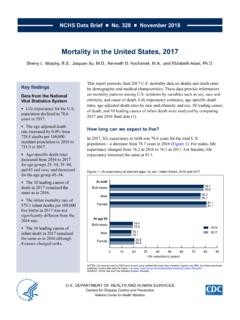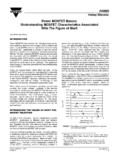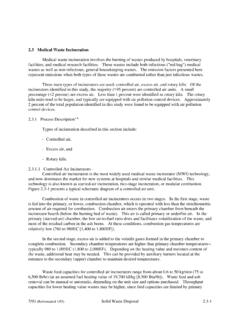Transcription of Mortality in the United States, 2015
1 NCHS Data Brief No. 267 December DEPARTMENT OF HEALTH AND HUMAN SERVICESC enters for Disease Control and PreventionNational Center for Health StatisticsMortality in the United States, 2015 Jiaquan Xu, , Sherry L. Murphy, , Kenneth D. Kochanek, , and Elizabeth Arias, Key findingsData from the National Vital Statistics System, Mortality Life expectancy for the population in 2015 was years, a decrease of year from 2014. The age-adjusted death rate increased from deaths per 100,000 standard population in 2014 to in 2015. The 10 leading causes of death in 2015 remained the same as in 2014. Age-adjusted death rates increased for eight leading causes and decreased for one.
2 The infant Mortality rate of infant deaths per 100,000 live births in 2015 was not significantly different from the 2014 rate. The 10 leading causes of infant death in 2015 remained the same as in 2014, although two causes exchanged report presents 2015 final Mortality data on deaths and death rates by demographic and medical characteristics. These data provide information on Mortality patterns among residents by variables such as sex, race and ethnicity, and cause of death. Life expectancy estimates, age-adjusted death rates by race and ethnicity and sex, 10 leading causes of death, and 10 leading causes of infant death were analyzed by comparing 2015 and 2014 final data (1).
3 Keywords: life expectancy leading cause National Vital Statistics SystemHow long can we expect to live?In 2015, life expectancy at birth was years for the total population a decrease of year from years in 2014 (Figure 1). For males, life expectancy changed from years in 2014 to years in 2015 a decrease of years, and for females, life expectancy decreased year from years in 2014 to years in 1. Life expectancy at selected ages, by sex: United States, 2014 and 2015 NOTES: Life expectancies for 2014 were revised using updated Medicare data; therefore, figures may differ from those previously published.
4 Access data table for Figure 1 at: # : NCHS, National Vital Statistics System, expectancy (years) birthAt age Data Brief No. 267 December 2016 2 Life expectancy for females was consistently higher than it was for males. In 2015, the difference in life expectancy between females and males increased year from years in 2014 to years in 2015, life expectancy at age 65 for the total population was years, the same as in 2014. Life expectancy at age 65 was years for females and years for males, both unchanged from 2014. The difference in life expectancy at age 65 between females and males remained at years in are the age-adjusted death rates for race-ethnicity-sex groups?
5 The age-adjusted death rate for the total population increased from per 100,000 standard population in 2014 to in 2015 (Figure 2). Age-adjusted death rates increased in 2015 from 2014 for non-Hispanic black males ( ), non-Hispanic white males ( ), and non-Hispanic white females ( ). Rates did not change significantly for non-Hispanic black females, Hispanic males, and Hispanic females from 2014 to femaleWhite maleBlack femaleBlack , , 2. Age-adjusted death rates for selected populations: United States, 2014 and 2015 1 Statistically significant increase in age-adjusted death rate from 2014 to 2015 (p < ).NOTE: Access data table for Figure 2 at: # : NCHS, National Vital Statistics System, per 100,000 standard population02004006008001,0001,2002014201 5 Non-HispanicHispanicNCHS Data Brief No.
6 267 December 2016 3 What are the leading causes of death?In 2015, the 10 leading causes of death (heart disease, cancer, chronic lower respiratory diseases, unintentional injuries, stroke, Alzheimer s disease, diabetes, influenza and pneumonia, kidney disease, and suicide) remained the same as in 2014 (Figure 3). The 10 leading causes accounted for of all deaths in the United States in 2014 to 2015, age-adjusted death rates increased for 8 of 10 leading causes of death and decreased for 1. The rate increased for heart disease, for chronic lower respiratory diseases, for unintentional injuries, for stroke, for Alzheimer s disease, for diabetes, for kidney disease, and for suicide.
7 The rate decreased by for cancer. The rate for influenza and pneumonia did not change per 100,000 standard population1 Statistically significant increase in age-adjusted death rate from 2014 to 2015 (p < ).2 Statistically significant decrease in age-adjusted death rate from 2014 to 2015 (p < ).NOTES: A total of 2,712,630 resident deaths were registered in the United States in 2015. The 10 leading causes accounted for of all deaths in theUnited States in 2015. Causes of death are ranked according to number of deaths. Access data table for Figure 3 at: # : NCHS, National Vital Statistics System, 3. Age-adjusted death rates for the 10 leading causes of death in 2015: United States, 2014 and diseaseInfluenza andpneumoniaDiabetesAlzheimer s diseaseStrokeUnintentional injuriesChronic lowerrespiratory diseasesCancerHeart diseaseNCHS Data Brief No.
8 267 December 2016 4 What are the leading causes of infant death?The infant Mortality rate (IMR) the ratio of infant deaths to live births in a given year is generally regarded as a good indicator of the overall health of a population. The IMR changed from infant deaths per 100,000 live births in 2014 to in 2015, but this change was not statistically 10 leading causes of infant death in 2015 accounted for of all infant deaths in the United States. The leading causes remained the same as in 2014, although two causes exchanged ranks (Figure 4). The IMR for unintentional injuries increased from infant deaths per 100,000 live births in 2014 to in 2015.
9 Mortality rates for other leading causes of infant death did not change deaths per 100,000 live significant increase in Mortality rate from 2014 to 2015 (p < ).NOTES: A total of 23,455 deaths occurred in children under age 1 year in the United States in 2015, with an infant Mortality rate of infant deaths per100,000 live births. The 10 leading causes of infant death in 2015 accounted for of all infant deaths in the United States. Causes of death are rankedaccording to number of deaths. Access data table for Figure 4 at: # : NCHS, National Vital Statistics System, 4. Infant Mortality rates for all causes and the 10 leading causes of infant death in 2015: United States, 2014 and 2015 hemorrhageDiseases of thecirculatory systemRespiratory distressof newbornBacterial sepsisof newbornCord and placentalcomplicationsUnintentional injuriesMaternal complicationsSudden infantdeath syndromeLow birth weightCongenitalmalformationsAll causesNCHS Data Brief No.
10 267 December 2016 5 SummaryIn 2015, a total of 2,712,630 resident deaths were registered in the United States 86,212 more deaths than in 2014. From 2014 to 2015, the age-adjusted death rate for the total population increased , and life expectancy at birth decreased year. The age-adjusted death rate increased for non-Hispanic white males, non-Hispanic white females, and non-Hispanic black males. The rate for the total population rose significantly for the first time since 1999 (1).The 10 leading causes of death in 2015 remained the same as in 2014. Age-adjusted death rates increased for eight leading causes. The only decrease in age-adjusted death rates among the 10 leading causes of death was for cancer.

















